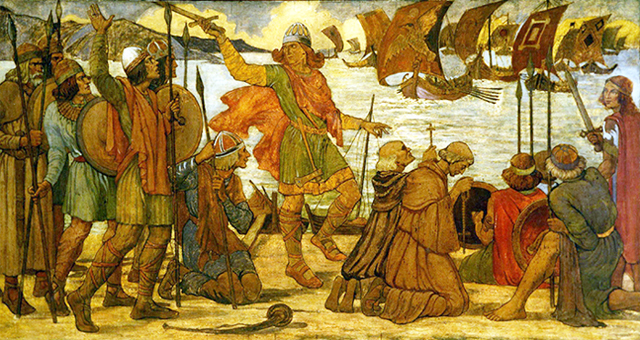Cambro-Norse Viking era
The Viking invasions of Wales, it was named the Cambro-Norse era spanning the years 850s to 1100s. The emergence of the Royal House of Aberffraw and the prequel to the Norman invasion of the British Isles (Wikipedia articles linked).
The Cambro-Norse (Welsh-Scandinavian) era began with the Viking invasion of the British Isles from the 9th century onwards for 200 years. The medieval invasive forces were from northern Scandinavia and they raided and pillaged for centuries, this was after the Anglo-Saxons invaded in the 5th century continuously by integrating into English Kingdoms. By the 850s, the Kingdoms of Gwynedd and Powys in North Wales had been subjugated by the English Kingdom of Mercia aided by the Saxons for a century. However, everything was about to change.
By the decade of the 870s, the Second Dynasty of Gwynedd as the Royal House of Aberffraw was emerging as a new dynasty in Gwynedd. Rhodri the Great (Welsh: Mawr) was the King of Wales and the King of the Britons. He had gone to war with his neighbouring English Kingdoms of Mercia and Wessex to the south. His father was Merfyn Frych, and he began the war against Mercia and successfully kept his territories as King of Gwynedd. However, the ongoing war would continue for decades from 817 until 881. It involved the numerous reigning monarchs and their descendants continuing the battles for the best part of a century. The conflicts came to an end when Rhodri the Great was killed in battle against the English Mercian Saxon leader Ceowulf of Mercia in 878. But the Welsh would avenge their King, and the war culminated in seeing Rhodri's son Anarawd come out of the Battle of Conwy successfully defeating the Mercian Lord Æthelred and also the Kingdom of Wessex for the final time in 881. After the war with the English and Saxons the House of Aberffraw would become dependent on the Scandanavian York (Old Norse: Jórvík) mercenaries for protection.
 |
| Image courtesy of Wikimedia Commons, attributed to Roxanna, Vikings landing in Dublin 841. |
The Cambro-Norse era was defined by the Viking raids in Wales between the 9th and 11th centuries. The first period was between the years 852 and 919 and the Vikings referred to the era in the Jómsvíkinga saga. It involved raiding, pillaging and slave raiding. This period of Viking suppression would continue in the early to mid-10th century and then into the final period between 950 and 998. During this third and final time, the Vikings raided the royal court of Aberffraw in 968. It was King Maerdudd ab Owain of Gwynedd who would pay the ransom for the return of Welsh captives who were kidnapped as slaves by the Scandinavian Vikings.
The era culminated in the Norman conquest and the triple threat that came to a close at the battle of Hastings in England in 1066 with William the Conqueror of Normandy. He was a Frenchman who descended from the 9th-century Viking ruler Rollo. William had beaten the King of England who in turn had already defeated the Viking King of Norway before his loss in battle. William would establish the House of Normandy and claim the crown of England in the process of eliminating the Saxon and Viking alliance. His descendants would claim the title of Emperor of the Romans throughout Europe.
The final line of defence against invasion for Gwynedd and Wales came in the form of Gruffudd ap Cynan of the House of Aberffraw, and founder of the first of Five Royal Tribes of Wales, who was supported by his family of Viking mercenaries. Gruffudd's father, Cynan ap Iago was King of Gwynedd but he fled to the Kingdom of Dublin but was murdered by his own men. Cynan married the Gael-Norse daughter of Amlaib Mac Sitriuc (Olaf Sigtryggsson), a descendant of the Scandinavian Vikings who settled the Irish Sea, especially Dublin. Gruffudd's alliance propelled him to a position of power to control a fleet of Viking mercenaries who travelled the seas. They successfully attacked Norman-controlled Gwynedd on several occasions (1075, 1081, 1094, 1101) to reclaim his ancestral inheritance, but lost all their gains all but the last attempt. Gruffudd's ambition met no match in Wales and he went as far as to kill his own kin in 1081 when he battled the King of Gwynedd with Rhys ap Tewdwr of the House of Dinefwr. They defeated Trahaern ap Caradog at the Battle of Mynydd Carn in St. David's, Wales. However, Gruffudd was caught by the Normans and jailed for over a decade from 1081 before finally escaping his incarceration in Chester to reclaim Gwynedd once and for all after the Battle of Anglesey Sound in 1098. This was when he was assisted by Magnus Bearfoot the King of Norway and also of the newly formed Kingdom of the Isles (islands surrounding Scotland). Gruffudd ap Cynan started a new dynasty after the Merfynion from the Isle of Man in the 8th and 9th centuries. This time again in the Irish Sea, but it was from Viking-controlled Dublin in Ireland they took Gwynedd, and then under the new guise of the Celtic (native) Princes of Wales (Princeps Walliarum in Latin). This title would inspire a new wave of leaders in Wales to defend their country over foreign invaders for a century, first the Normans, then the English. Gruffudd's Viking heritage would determine the alliance between the Dubliners and the Welsh of Gwynedd when the Cambro-Norse era came to a close. The Prince of Wales title would be made official and incorporated into the English crown as of 1301 and it continues to date.
Comments
Post a Comment